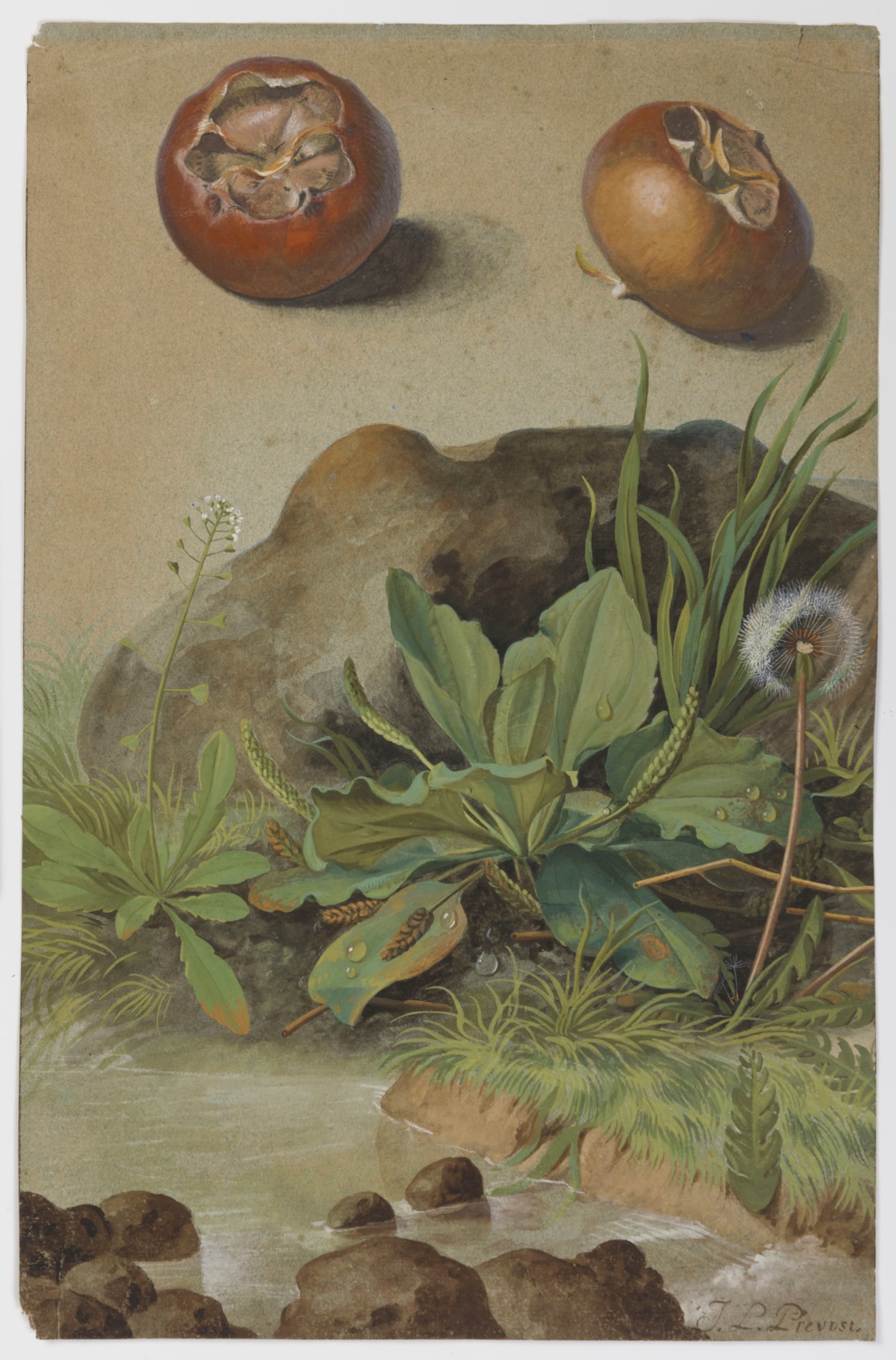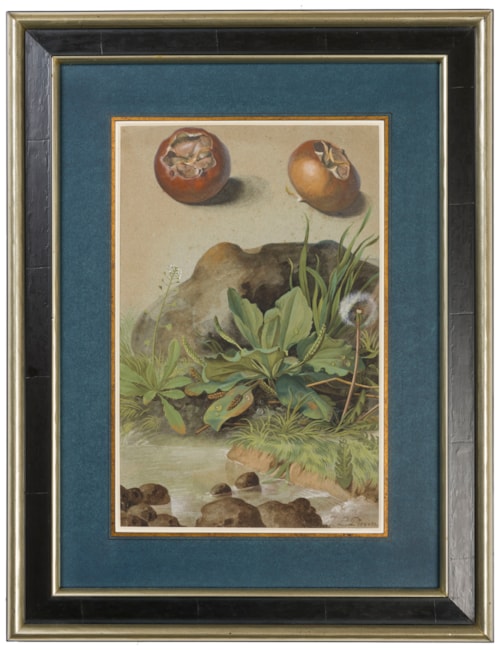Jean-Louis PRÉVOST
(Nointel 1745 - Paris 1827)
Two Medlars and Wild Plants by a Stream
Watercolour and gouache, with traces of a framing line in brown ink, on faded blue paper.
Signed J. L. Prevost at the lower right.
349 x 226 mm. (13 3/4 x 8 7/8 in.)
Signed J. L. Prevost at the lower right.
349 x 226 mm. (13 3/4 x 8 7/8 in.)
This fine watercolour typifies Jean-Louis Prévost’s close study of nature. As a modern scholar has noted, ‘With botanical fidelity and conscientiousness Prévost portrays the smallest detail: almost imperceptible drops of dew on leaf and petal, a small beetle hanging on a tendril. He possesses everything – strength and gentleness, passion and tenderness, a sense for grandeur and love for unconsidered trifle. He is neither pretentious, mannered nor sentimental. He approaches his subject with absolute objectivity and honesty. His technique consists in grace of brushwork and elegance of line drawing.’
Relatively little is known of the life of Jean-Louis Prévost the Younger, who was born into an extended family of artists who were particularly known as still life painters, and which included his brothers Jean-Jacques and Guillaume. Born in Nointel, near Beaumont-sur-Oise in northern France, Jean-Louis Prévost studied with the flower painter Jean-Jacques Bachelier at the Manufacture Royale de Sèvres and exhibited his work for the first time at the Académie Royale at the age of fourteen. Devoting himself mainly to paintings and watercolours of flowers and fruit subjects, Prévost was, together with his brothers, commissioned by the fermier-général Jacques-Jérémie Roussel to paint the plants and flowers in the gardens of his château at La Celle-Saint-Cloud, near Versailles, resulting in the twelve-volume compendium of around 1,800 gouache studies known as the Horti Cellensis Plantarum Icones, acquired by the Natural History Library in Paris in 1782. A member of the Académie de Saint-Luc, Prévost became known in particular for his botanical watercolours, which were regularly shown at the Paris Salons.
In 1791 Prévost began work on another volume of forty-eight botanical watercolours, which was eventually published, in several portfolios, with the title Collection de fleurs et fruits, peints d’après nature par Jean-Louis Prévost, et tirés de son portefeuille in 1805. Although highly accurate, these works were not overtly scientific in nature and were intended for the use of designers of fabric, embroidery and porcelain. By the middle of the 1790s Prévost had been granted accommodation in the Manufacture des Gobelins on the rue Mouffetard in Paris, where he lived for some thirty years. Many of Prévost’s watercolours were reproduced, with great sensitivity, as coloured prints by the stipple engraver Louis-Charles Ruotte. Works by Prévost are recorded in several important private collections in France in the late 18th and early 19th centuries - notably those of Louis François de Bourbon, the Prince de Conti, Augustin Blondel de Gagny, and Pierre-Louis Eveillard, Marquis de Livois - and a large number of gouaches by the artist are today in the collection of the Bibliothèque Nationale in Paris.
In 1791 Prévost began work on another volume of forty-eight botanical watercolours, which was eventually published, in several portfolios, with the title Collection de fleurs et fruits, peints d’après nature par Jean-Louis Prévost, et tirés de son portefeuille in 1805. Although highly accurate, these works were not overtly scientific in nature and were intended for the use of designers of fabric, embroidery and porcelain. By the middle of the 1790s Prévost had been granted accommodation in the Manufacture des Gobelins on the rue Mouffetard in Paris, where he lived for some thirty years. Many of Prévost’s watercolours were reproduced, with great sensitivity, as coloured prints by the stipple engraver Louis-Charles Ruotte. Works by Prévost are recorded in several important private collections in France in the late 18th and early 19th centuries - notably those of Louis François de Bourbon, the Prince de Conti, Augustin Blondel de Gagny, and Pierre-Louis Eveillard, Marquis de Livois - and a large number of gouaches by the artist are today in the collection of the Bibliothèque Nationale in Paris.








